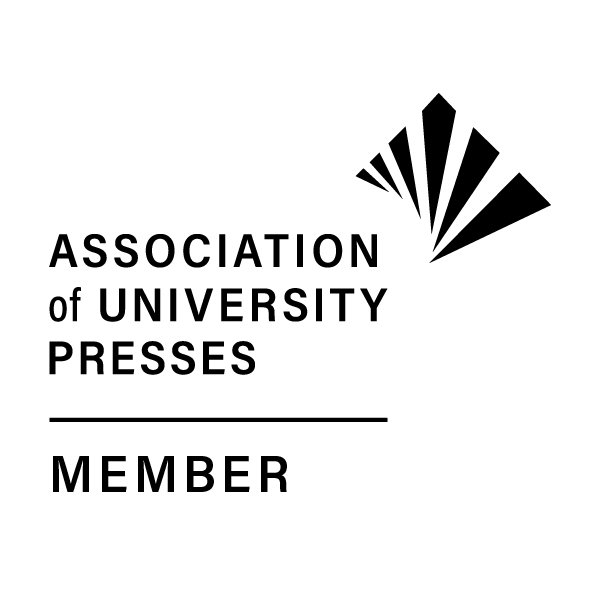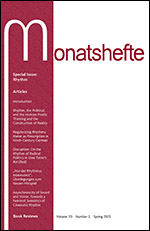|


|

Subscribe
Read the Journal Online
Submission Guidelines
Editorial Board
Receive Email Updates
Advertise in Monatshefte
Indexes/Abstracts
Current Issue TOC
Back Issues TOC
Monatshefte 2022 Subscription Rates
Institutions:
print & online $271
online only $233
Individuals:
print & online $103
online only $86
Non U.S. Postage (no postage charges for online-only subscriptions)
Airmail: add $40/yr.
Canadian Subscribers: add 5% GST. |
Monatshefte
Volume 104, Number 1, Spring 2012 Table of Contents
Articles
Christian Clement
Trauerspiel und Offenbarung: Apokalyptik als Reflexionsfläche ästhetischer Theorie in Andreas Gryphius’ Catharina von Georgien
Abstract:
This article explores the extensive use of apocalyptic imagery in Andreas Gryphius’ drama Catharina von Georgien. The author argues that in this play, Gryphius uses apocalypticism not only as a literary tool to demonstrate the futility of all worldly things, as was common in baroque literature, but also as a medium of reflecting about and illustrating drama theory. As Gryphius describes how drama can facilitate a deeper understanding of the world and the self, he refers to mystical concepts such as imitatio and unio, thus establishing a theory of drama which closely links not only aesthetics and apocalypse, but also aesthetic and mystical experience. Thus drama itself turns into a genuine apocalypse, whose purpose it is to facilitate transcendent experience. (CC; in German)
Arlene A. Teraoka
A Faustian Versprechen: Dürrenmatt, Staiger, and Late Goethe
Abstract:
Friedrich Dürrenmatt’s detective novel of 1958, Das Versprechen, begins by mentioning a lecture by Emil Staiger on late Goethe that draws a large audience in the Swiss city of Chur, leaving only a few to attend a competing talk that same evening by a Swiss author on the art of writing crime novels. This essay makes an argument for Das Versprechen as Dürrenmatt’s critique of the ethical and political stance embedded in Staiger’s aesthetics and, in particular, in Staiger’s reading of Goethe’s Faust. The discussion draws connections among the powerful aura of the Swiss literary critic Emil Staiger in the 1950s postwar era; the comforting idyllic self-image of Switzerland as a country of democracy, prosperity, and neutrality; and disturbing references to Goethe’s Faust in Dürrenmatt’s novel of a serial child murderer. (AAT)
Silke Brodersen
Reality as Image-Making: Collective Kulturbilder and Subjective Perspective in C.F. Meyer’s Historical Novella Die Hochzeit des Mönchs
Abstract:
This article interprets the use of images and visuality as interplay between subjective perception and collective imaginary in C.F. Meyer’s realist novella Die Hochzeit des Mönchs. I argue that Meyer’s novella employs the art historian Jacob Burkhardt’s notion of Kulturbild as an epistemological model to discuss both the construction of modern subjectivity in Renaissance art and its crisis in the nineteenth century due to the re-emergence of excluded bodily desire. Like Burkhardt, Meyer uses images as both source and medium for historical analysis, but shows the subjective gaze (and consequently its objective field of vision) in Renaissance style to be complicated by ambiguity, multivalence, and in authenticity: the text demonstrates that subjectivity is predetermined by collective cultural imagery and limited by the non-representational mythical space of the body. Thus, while Meyer, as has been previously suggested, celebrates the self-assured power of the Renaissance man, he also demonstrates the illusionary quality of his vision which does not offer unadulterated access to ‘nature,’ instead revealing the subjective perspective to be an uneasy patchwork of conflicting cultural visions on the verge of breakdown. (SB)
Kristen Hylenski
Die “Not der Zeit”: Moderntiy in Frank Wedekind’s Dance Poems
Abstract:
In his drama, prose, and poetry, Frank Wedekind often focused on the figure of the dancer. A thematic and formal analysis of the poems “Tingel-Tangel,” “Grand Ecart,” “Modernes Mädchen, and “Junges Blut” demonstrates how dance and the dancer function for Wedekind as a central way to articulate an experience of modernity rooted in motion and speed. Reading the poems in the context of dance and cabaret traditions reveals how dance gives form to the perceived crisis of modernity, while also providing refuge from it. (KH)
Christoph Zeller
Language of Immediacy: Authenticity as a Premise in Benjamin’s The Work of Art in the Age of Its Technological Reproducibility
Abstract:
Walter Benjamin’s essay on The Work of Art in the Age of Its Technological Reproducibility is as popular as it is disputed. Although illuminating different qualities of artworks and their perception, the historical shift from auratic to reproducible art is inconsistent. This inconsistency, as this article suggests is caused by the concept of authenticity that Benjamin applies to both auratic and reproducible art. Authenticity refers to the utopian ideas of ‘purity,’ ‘unity,’ ‘truth,’ and ‘originality’ that dominated avant-garde aesthetics in the early twentieth century. Since then, ‘authentic’ artworks commonly either hint at an inaccessible origin beyond their medial status (auratic art) or emphasize their mediality by declaring the elements of their ‘truth’ (reproducible art). Benjamin’s explorations of media, aesthetics, and culture draw on this under-researched, dualistic idea of mediated immediacy. (CZ)
Gary L. Baker
The Involution of History in Uwe Timm’s Am Beispiel meines Bruders
Abstract:
In Am Beispiel meines Bruders Uwe Timm blends the pain of traumatic loss at the familial level with history writing in a narrative that suggests that trauma in endemic to all the writings and family stories that he employs. In order to elucidate Timm’s distinctive approach to history the essay combines Cathy Caruth’s disputed trauma-as-history equation with the notion of involution as a manner of interpreting culture. In an investigation of the past on simultaneous familial and national levels Timm embeds an intimate scene of his father sobbing. This scene serves as a prime instance of trauma-as-history and an illustration of how Timm’s narrative involutes history back into the trauma that is endemic to its writing in the first place. Timm’s works synthesizes both traumatic and historical elements, creating a narrative formula that precludes the dissociating effects of what Erich Santer calls “narrative fetishism.” His work leads instead to a narrative with an embedded elaborating quality that instills active reflection and differentiating perspectives in the reader. Where past events are viewed through the trauma they cause, history is involuted thus creating a paradigmatic rather than syntagmatic form in its conflation of national, familial and (auto)biographical history. (GLB)
Book Reviews
Borgards, Roland und Harald Neumeyer, Hrsg., Büchner-Handbuch. Leben—Werk—Wirkung (John B. Lyon)
Boyken, Thomas, Ina Cappelmann und Uwe Schwagmeier, Hrsg., Rolf Dieter Brinkmann. Neue Perspektiven. Orte—Helden—Körper (Martin Kagel)
Butler, Erik, Metamorphoses of the Vampire in Literature and Film: Cultural Transformations in Europe, 1732–1933 (Thomas W. Kniesche)
Dencker, Klaus Peter, Optische Poesie. Von den prähistorischen Schriftzeichen bis zu den digitalen Experimenten der Gegenwart (Peer Trilcke)
Gamper, Michael, Elektropoetologie. Fiktionen der Elektrizität 1740–1870 (Gunhild Berg)
Göttsche, Dirk und Ulf-Michael Schneider, Hrsg., Signaturen realistischen Erzählens im Werk Wilhelm Raabes (Robert L. Jamison)
Groddeck, Wolfram, Hrsg., Der grüne Heinrich. Gottfried Kellers Lebensbuch—neu gelesen (Paul Fleming)
Henkel, Gabriele, Hrsg., Wilhelm Raabe. Das zeichnerische Werk (Monika Schmitz-Emans)
Hirt, Katherine, When Machines Play Chopin: Musical Spirit and Automation in Nineteenth-Century German Literature (Mary Helen Dupree)
Holmes, Deborah and Lisa Silverman, eds., Interwar Vienna: Culture between Tradition and Modernity (Katherine Arens)
Klein, Christian, Hrsg., Handbuch Biographie. Methoden, Traditionen, Theorien (Heinrich Detering)
Kontje, Todd, Thomas Mann's World: Empire, Race, and the Jewish Question (Yahya Elsaghe)
Kord, Susanne, Murderesses in German Writing, 1720–1860: Heroines of Horror (Catherine Grimm)
Mecke, Jochen, Hrsg., Medien der Literatur. Vom Almanach zur Hyperfiction. Stationen einer Mediengeschichte der Literatur vom 18. Jahrhundert bis zur Gegenwart (Peter Krapp)
Mix, York-Gothart und Jochen Strobel, Hrsg., Der Europäer A.W. Schlegel. Romantischer Kulturtransfer—romantische Wissenswelten (Jocelyn Holland)
Münker, Stefan, Philosophie nach dem “Medial Turn”. Beiträge zur Theorie der Mediengesellschaft (Henning Wrage)
Neuhuber, Christian, Georg Büchner. Das literarische Werk (John B. Lyon)
Niekerk, Carl, Reading Mahler: German Culture and Jewish Identity in Fin-de-Siècle Vienna (James L. Zychowicz)
Nindl, Sigrid, Wolf Haas und sein kriminalliterarisches Sprachexperiment (Jochen Vogt)
Scherer, Stefan, Einführung in die Dramen-Analyse (Ralf Remshardt)
Schmidt, Wolf Gerhard, Zwischen Antimoderne und Postmoderne. Das deutsche Drama und Theater der Nachkriegszeit im internationalen Kontext (Helga W. Kraft)
Specht, Benjamin, Physik als Kunst. Die Poetisierung der Elektrizität um 1800 (Gunhild Berg)
Stamm, Ulrike, Der Orient der Frauen. Reiseberichte deutschsprachiger Autorinnen im frühen 19. Jahrhundert (Ulrike Brisson)
Tucker, Brian, Reading Riddles: Rhetorics of Obscurity from Romanticism to Freud (Gabriel Trop)
Walker, John, The Truth of Realism: A Reassessment of the German Novel 1830–1900 (Jeffrey L. Sammons)
|


